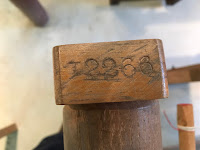 |
| Kids love the beating part of rug weaving |
Weaving through a historical lens
If you have ever spun or woven in public, you know that there is little to no understanding of either craft among the general public.Not unlike the lack of connection between farm production and supermarket displays, the public in general has little to no concept of fabric construction. Industrialization separates us from understanding some of the essential building blocks of humankind.
I recently spent a day weaving at Walnford Day at Monmouth County Park System's Historic Walnford House in Upper Freehold, N.J. That's somewhat of a misnomer as I spent most of the time talking about historical precedent, how and why weaving was important to colonials, and helping the public, many of them children, weave a few shots. It was a really good day and I loved it.
 |
| Newcomb/Sears Fairloom back view/sectional beam |
Historic Walnford has three operating looms that have been gifted to the property, none of which is period. The vintage Sears Fairloom, which was made and sold by Newcomb Loom Company as its Studio Art loom, is warped to weave rag rugs and used for education and sampling by the public.
 |
| Newcomb identification number |
Although the Newcomb Loom Company, which was established in Davenport, Iowa in 1889, ceased operations in the 1980's, Newcomb looms are still being used by weavers. If you have one, you can add it to the registry hosted by Weaver's Delight for a very modest fee, find parts and order a copy of the original instruction manual.For Walnford Day, it was a time to introduce people to the frugality of former times. I took along strips of cotton fabric for the rag rugs and they served as a great conversation starter. As I talked about colonialists' frugality and how they repurposed as much as possible, I asked what they thought the fabric was from. (It was from an old bed sheet.) Surprising even to me was how many people didn't even know where to start.
No fancy dress, thank you
Dressing in period costume was not required for the day. I don't have costume, so obviously, I didn't. But some presenters did. The spinner, for example, had a lovely outfit complete with a charming little hat set sideways just so. And it got me thinking about period costumes for history days like this.Here is my problem: Spinners and weavers don't dress in lovely outfits to perform their work now--and they never did. They need to move. They're engaging in physical labor. Weavers, even more than spinners, need to throw shuttles (long sleeves would interfere) and to crawl under the loom (unless they're production and have a loom boy, i.e., child labor). These are not jobs for ladies sitting in parlors with an embroidery hoop.
The dressing up in Sunday bests for the middle and upper-classes is colorful and fun, but it does not convey the hard lives that most people lived.
If I were dressing to weave or spin in a historical context, I'd wear a coarse cotton or cotton and linen shift-style dress in a natural color. If a head covering were needed, it would be a simple scarf.
What a beautiful piece of artical to read!I have read about the love the weaver have been sharing with each other just like a family member.
ReplyDelete